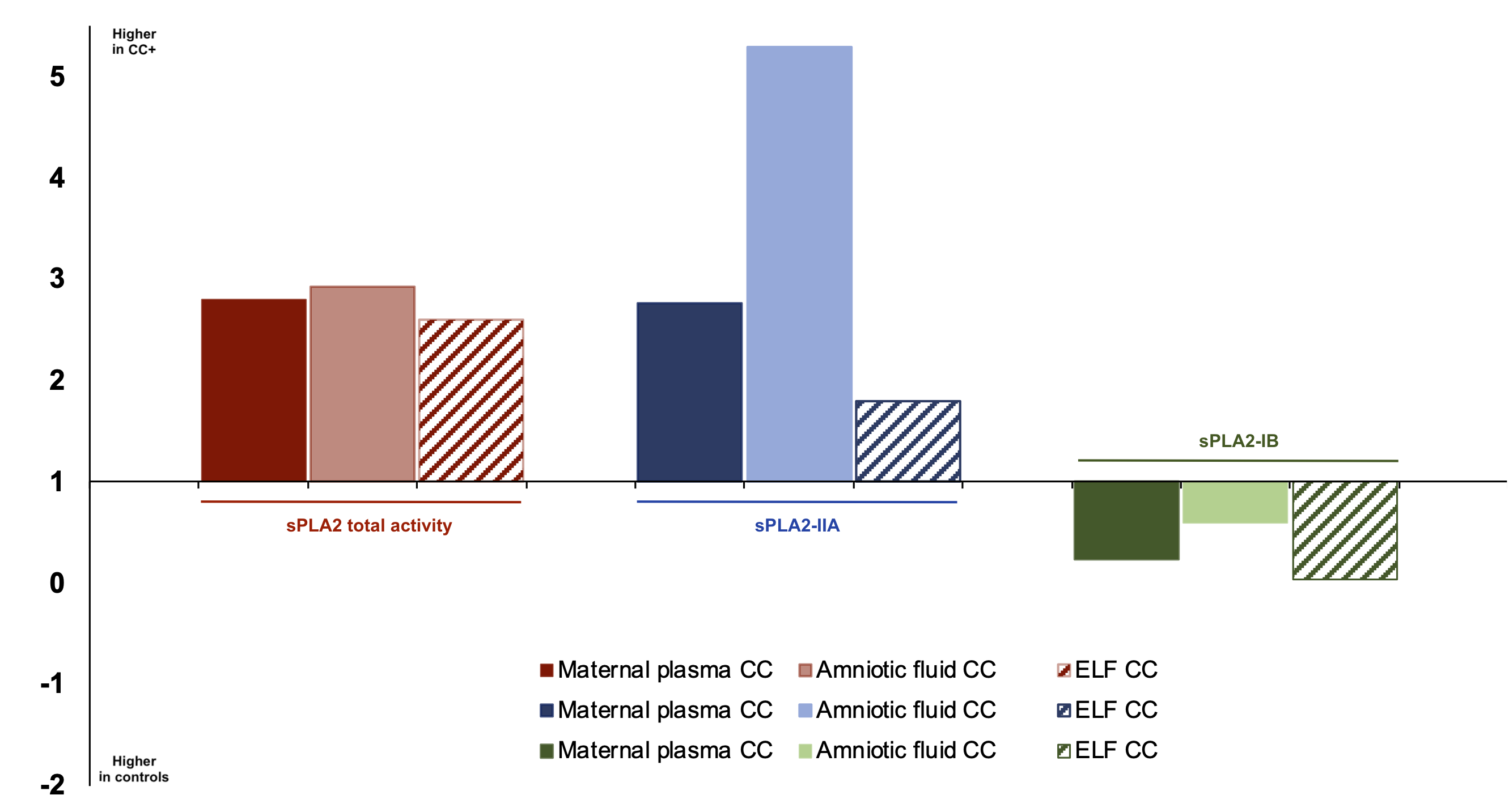Back
Neonatal Pulmonology
Category: Abstract Submission
Neonatal Pulmonology I: Antenatal Exposures
430 - Secretory phospholipase A2 expression and activity in preterm clinical chorioamnionitis with fetal involvement
Monday, April 25, 2022
3:30 PM – 6:00 PM US MT
Poster Number: 430
Daniele M. De Luca, Paris Saclay University - "A.Beclere" Hospital, Clamart (Paris), Ile-de-France, France; Silvia Foligno, University Hospital Antoine Béclère , Paris, Paris, Ile-de-France, France; Chiara Autilio, Complutense University of Madrid, Madrid, Madrid, Spain; Alexandre J. Vivanti, Paris Saclay University, Clamart, Ile-de-France, France; Lhousseine Touqui, Institut Pasteur, Paris, Ile-de-France, France

Daniele De Luca, MD, PhD (he/him/his)
Full Professor
APHP-Paris Saclay University
Paris, Ile-de-France, France
Presenting Author(s)
Background: Secretory phospholipase A2 (sPLA2) regulates the first step of inflammatory cascade and is involved in several pathological processes. sPLA2 also plays a role in preterm labor and parturition, since they are triggered by inflammatory mediators such as prostaglandins, produced by the inflammatory cascade in further steps following the sPLA2 reaction. Interestingly, chorioamnionitis, that is the presence of intrauterine inflammation is often associated with preterm birth.
Objective: We aimed to verify if chorioamnionitis with fetal involvement modifies the sPLA2 activity and expression profile in mothers and neonates when these are delivered prematurely.
Design/Methods: Prospective, translational, pragmatic, cohort study representing a side study of a larger project on the role of sPLA2 in critical respiratory conditions (De Luca D. BMC Pediatr 2011). We collected maternal plasma and amniotic fluid, as well as bronchoalveolar lavage fluid from preterm neonates born to mothers with (n=27) or without (n=32) clinical chorioamnionitis with fetal involvement. We used ELISA to measure sPLA2 subtype-IIA and -IB. We measured total enzyme activity with colorimetric or radioactive assays. Total proteins were used to correct plasma amniotic fluid concentrations and proteins; urea ratio was used to obtain epithelial lining fluid concentrations. To confirm results, we analyzed cytokines known to increase sPLA2-IIA expression (TNF-alpha, IL-1Beta) or whose expression is increased by sPLA2-IIA (IL-8) in cases with or without histologically confirmed chorioamnionitis and fetal involvement. Placental histology was performed according to Amsterdam consensus criteria.
Results: Enzyme activity measured in maternal plasma (p < 0.001) and amniotic fluid (p < 0.001) is higher in chorioamnionitis cases than in controls. This is mainly due the increased production of sPLA2-IIA, since it is increased or tend to be increased in chorioamnionitis cases, while the subtype -IB is present in smaller amount and is similar between the two groups (see Figure). TNF-alpha p=0.028), (IL-1Beta p < 0.001) and IL-8 (p=0.038) were higher in histologically confirmed chorioamnionitis.Conclusion(s): sPLA2 activity is increased and mainly due to augmented production of sPLA2-IIA in mother-neonate dyad affected by chorioamnionitis with high likelihood of fetal involvement ending up in preterm delivery. These data represent the basis for future studies on sPLA2-IIA inhibition to prevent deleterious consequences of chorioamnionitis and preterm birth.
Figure. Secretory phospholipases in different samples, normalized as unit-free chorioamnionitis cases/controls ratio. Red, blue and green columns represent sPLA2 total activity, sPLA2-IIA and sPLA2-IIB concentrations, respectively. Fully and lightly colored columns represent measurements in maternal plasma and amniotic fluid, respectively. Columns filled with diagonal lines represent measurements in epithelial lining fluids. Data are expressed as ratios between the median concentrations, except that for sPLA2 subtypes in epithelial lining fluid where the ratio between mean concentrations was used (for arithmetic reasons, since a median value was zero). Abbreviations: CC+: chorioamnionitis cases; ELF: epithelial lining fluid, sPLA2: secretory phospholipase A2.
Red, blue and green columns represent sPLA2 total activity, sPLA2-IIA and sPLA2-IIB concentrations, respectively. Fully and lightly colored columns represent measurements in maternal plasma and amniotic fluid, respectively. Columns filled with diagonal lines represent measurements in epithelial lining fluids. Data are expressed as ratios between the median concentrations, except that for sPLA2 subtypes in epithelial lining fluid where the ratio between mean concentrations was used (for arithmetic reasons, since a median value was zero). Abbreviations: CC+: chorioamnionitis cases; ELF: epithelial lining fluid, sPLA2: secretory phospholipase A2.
Objective: We aimed to verify if chorioamnionitis with fetal involvement modifies the sPLA2 activity and expression profile in mothers and neonates when these are delivered prematurely.
Design/Methods: Prospective, translational, pragmatic, cohort study representing a side study of a larger project on the role of sPLA2 in critical respiratory conditions (De Luca D. BMC Pediatr 2011). We collected maternal plasma and amniotic fluid, as well as bronchoalveolar lavage fluid from preterm neonates born to mothers with (n=27) or without (n=32) clinical chorioamnionitis with fetal involvement. We used ELISA to measure sPLA2 subtype-IIA and -IB. We measured total enzyme activity with colorimetric or radioactive assays. Total proteins were used to correct plasma amniotic fluid concentrations and proteins; urea ratio was used to obtain epithelial lining fluid concentrations. To confirm results, we analyzed cytokines known to increase sPLA2-IIA expression (TNF-alpha, IL-1Beta) or whose expression is increased by sPLA2-IIA (IL-8) in cases with or without histologically confirmed chorioamnionitis and fetal involvement. Placental histology was performed according to Amsterdam consensus criteria.
Results: Enzyme activity measured in maternal plasma (p < 0.001) and amniotic fluid (p < 0.001) is higher in chorioamnionitis cases than in controls. This is mainly due the increased production of sPLA2-IIA, since it is increased or tend to be increased in chorioamnionitis cases, while the subtype -IB is present in smaller amount and is similar between the two groups (see Figure). TNF-alpha p=0.028), (IL-1Beta p < 0.001) and IL-8 (p=0.038) were higher in histologically confirmed chorioamnionitis.Conclusion(s): sPLA2 activity is increased and mainly due to augmented production of sPLA2-IIA in mother-neonate dyad affected by chorioamnionitis with high likelihood of fetal involvement ending up in preterm delivery. These data represent the basis for future studies on sPLA2-IIA inhibition to prevent deleterious consequences of chorioamnionitis and preterm birth.
Figure. Secretory phospholipases in different samples, normalized as unit-free chorioamnionitis cases/controls ratio.
 Red, blue and green columns represent sPLA2 total activity, sPLA2-IIA and sPLA2-IIB concentrations, respectively. Fully and lightly colored columns represent measurements in maternal plasma and amniotic fluid, respectively. Columns filled with diagonal lines represent measurements in epithelial lining fluids. Data are expressed as ratios between the median concentrations, except that for sPLA2 subtypes in epithelial lining fluid where the ratio between mean concentrations was used (for arithmetic reasons, since a median value was zero). Abbreviations: CC+: chorioamnionitis cases; ELF: epithelial lining fluid, sPLA2: secretory phospholipase A2.
Red, blue and green columns represent sPLA2 total activity, sPLA2-IIA and sPLA2-IIB concentrations, respectively. Fully and lightly colored columns represent measurements in maternal plasma and amniotic fluid, respectively. Columns filled with diagonal lines represent measurements in epithelial lining fluids. Data are expressed as ratios between the median concentrations, except that for sPLA2 subtypes in epithelial lining fluid where the ratio between mean concentrations was used (for arithmetic reasons, since a median value was zero). Abbreviations: CC+: chorioamnionitis cases; ELF: epithelial lining fluid, sPLA2: secretory phospholipase A2.